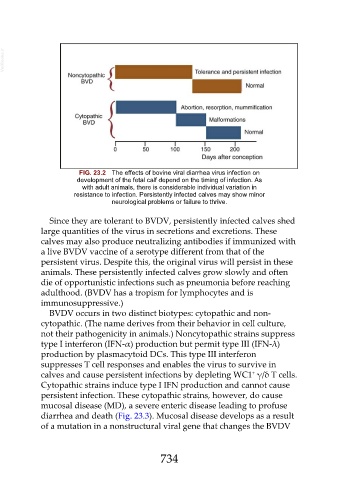Page 734 - Veterinary Immunology, 10th Edition
P. 734
VetBooks.ir
FIG. 23.2 The effects of bovine viral diarrhea virus infection on
development of the fetal calf depend on the timing of infection. As
with adult animals, there is considerable individual variation in
resistance to infection. Persistently infected calves may show minor
neurological problems or failure to thrive.
Since they are tolerant to BVDV, persistently infected calves shed
large quantities of the virus in secretions and excretions. These
calves may also produce neutralizing antibodies if immunized with
a live BVDV vaccine of a serotype different from that of the
persistent virus. Despite this, the original virus will persist in these
animals. These persistently infected calves grow slowly and often
die of opportunistic infections such as pneumonia before reaching
adulthood. (BVDV has a tropism for lymphocytes and is
immunosuppressive.)
BVDV occurs in two distinct biotypes: cytopathic and non-
cytopathic. (The name derives from their behavior in cell culture,
not their pathogenicity in animals.) Noncytopathic strains suppress
type I interferon (IFN-α) production but permit type III (IFN-λ)
production by plasmacytoid DCs. This type III interferon
suppresses T cell responses and enables the virus to survive in
+
calves and cause persistent infections by depleting WC1 γ/δ T cells.
Cytopathic strains induce type I IFN production and cannot cause
persistent infection. These cytopathic strains, however, do cause
mucosal disease (MD), a severe enteric disease leading to profuse
diarrhea and death (Fig. 23.3). Mucosal disease develops as a result
of a mutation in a nonstructural viral gene that changes the BVDV
734

